鲁菜英语介绍
- 格式:ppt
- 大小:3.58 MB
- 文档页数:22
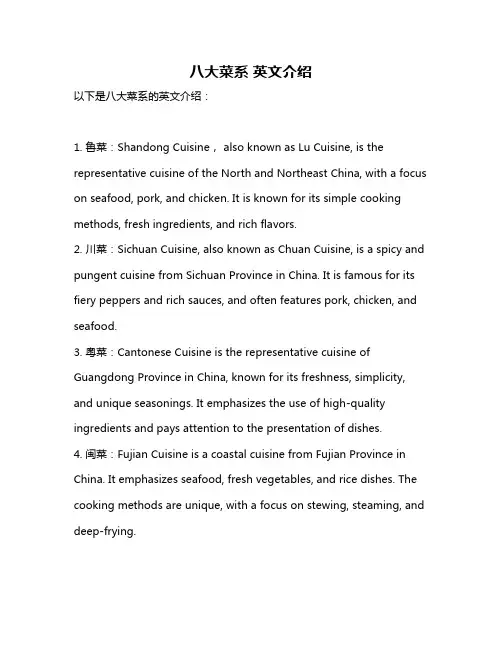
八大菜系英文介绍以下是八大菜系的英文介绍:1. 鲁菜:Shandong Cuisine, also known as Lu Cuisine, is the representative cuisine of the North and Northeast China, with a focus on seafood, pork, and chicken. It is known for its simple cooking methods, fresh ingredients, and rich flavors.2. 川菜:Sichuan Cuisine, also known as Chuan Cuisine, is a spicy and pungent cuisine from Sichuan Province in China. It is famous for its fiery peppers and rich sauces, and often features pork, chicken, and seafood.3. 粤菜:Cantonese Cuisine is the representative cuisine of Guangdong Province in China, known for its freshness, simplicity, and unique seasonings. It emphasizes the use of high-quality ingredients and pays attention to the presentation of dishes.4. 闽菜:Fujian Cuisine is a coastal cuisine from Fujian Province in China. It emphasizes seafood, fresh vegetables, and rice dishes. The cooking methods are unique, with a focus on stewing, steaming, and deep-frying.5. 苏菜:Jiangsu Cuisine is a representative cuisine of the Yangtze River Delta region in China. It emphasizes freshness, tenderness, and mild flavors. The cooking methods are diverse, including stewing, steaming, frying, and braising.6. 浙菜:Zhejiang Cuisine is a representative cuisine of the eastern region of China, known for its simplicity and unique flavors. It often features rice dishes, seafood, and various kinds of meat. The cooking methods include stewing, steaming, and frying.7. 湘菜:Xiang Cuisine is a spicy and pungent cuisine from Hunan Province in China. It emphasizes the use of fresh ingredients and fiery peppers, often featuring pork, chicken, and beef. The cooking methods include stewing, steaming, and deep-frying.8. 徽菜:Anhui Cuisine is a traditional Chinese cuisine from Anhui Province, known for its unique flavors and seasonings. The main ingredients include pork, chicken, duck, and various kinds of vegetables. The cooking methods include stewing, steaming, frying, and braising.。
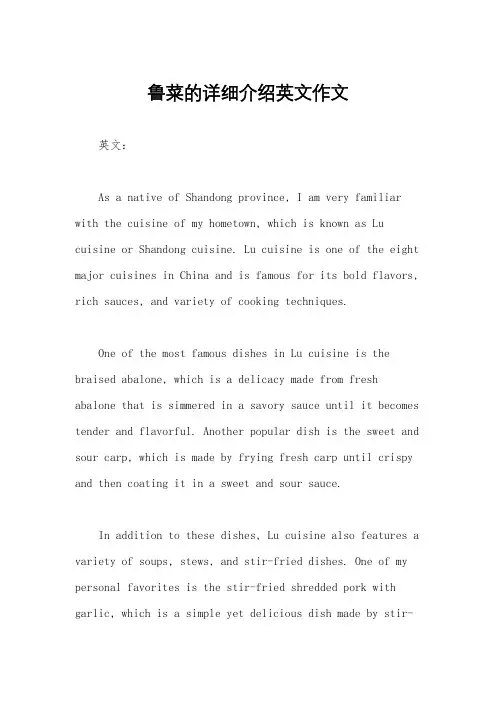
鲁菜的详细介绍英文作文英文:As a native of Shandong province, I am very familiar with the cuisine of my hometown, which is known as Lu cuisine or Shandong cuisine. Lu cuisine is one of the eight major cuisines in China and is famous for its bold flavors, rich sauces, and variety of cooking techniques.One of the most famous dishes in Lu cuisine is the braised abalone, which is a delicacy made from fresh abalone that is simmered in a savory sauce until it becomes tender and flavorful. Another popular dish is the sweet and sour carp, which is made by frying fresh carp until crispy and then coating it in a sweet and sour sauce.In addition to these dishes, Lu cuisine also features a variety of soups, stews, and stir-fried dishes. One of my personal favorites is the stir-fried shredded pork with garlic, which is a simple yet delicious dish made by stir-frying thinly sliced pork with garlic and green onions.Overall, Lu cuisine is a testament to the rich culinary traditions of Shandong province and is beloved by foodies around the world for its bold flavors and unique cooking techniques.中文:作为山东人,我非常熟悉我的家乡菜肴,也就是鲁菜或山东菜。
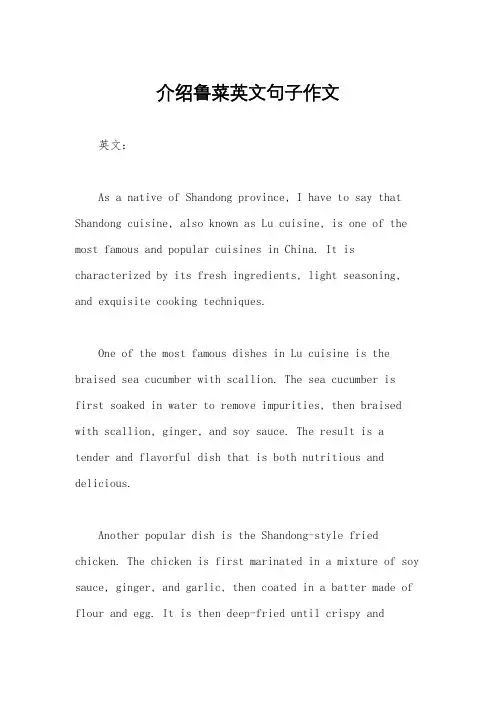
介绍鲁菜英文句子作文英文:As a native of Shandong province, I have to say that Shandong cuisine, also known as Lu cuisine, is one of the most famous and popular cuisines in China. It is characterized by its fresh ingredients, light seasoning, and exquisite cooking techniques.One of the most famous dishes in Lu cuisine is the braised sea cucumber with scallion. The sea cucumber isfirst soaked in water to remove impurities, then braised with scallion, ginger, and soy sauce. The result is a tender and flavorful dish that is both nutritious and delicious.Another popular dish is the Shandong-style fried chicken. The chicken is first marinated in a mixture of soy sauce, ginger, and garlic, then coated in a batter made of flour and egg. It is then deep-fried until crispy andgolden brown. The dish is often served with a sweet andsour sauce, which complements the savory flavor of the chicken.In addition to these dishes, Lu cuisine also features a wide variety of seafood, such as shrimp, crab, and squid,as well as meat dishes like braised pork belly and stir-fried beef with scallions.中文:作为山东人,我必须说,山东菜也就是鲁菜是中国最著名和最受欢迎的菜系之一。
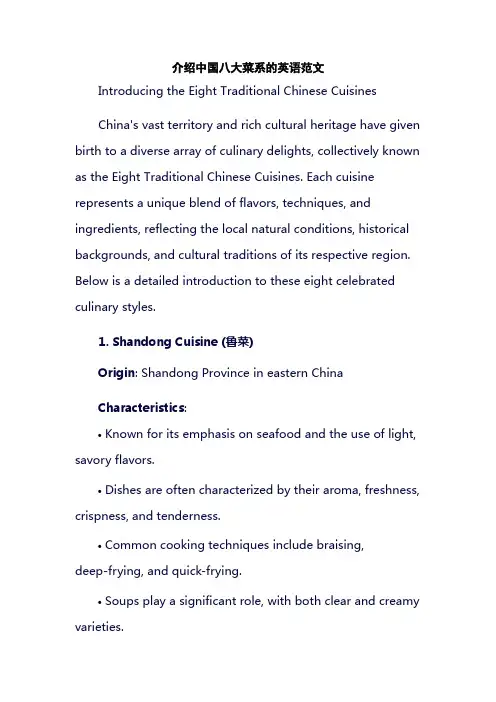
介绍中国八大菜系的英语范文Introducing the Eight Traditional Chinese CuisinesChina's vast territory and rich cultural heritage have given birth to a diverse array of culinary delights, collectively known as the Eight Traditional Chinese Cuisines. Each cuisine represents a unique blend of flavors, techniques, and ingredients, reflecting the local natural conditions, historical backgrounds, and cultural traditions of its respective region. Below is a detailed introduction to these eight celebrated culinary styles.1. Shandong Cuisine (鲁菜)Origin: Shandong Province in eastern ChinaCharacteristics:•Known for its emphasis on seafood and the use of light, savory flavors.•Dishes are often characterized by their aroma, freshness, crispness, and tenderness.•Common cooking techniques include braising,deep-frying, and quick-frying.•Soups play a significant role, with both clear and creamy varieties.Popular Dishes: Sweet and sour carp, braised abalone, fried sea cucumber, and sea cucumber braised with scallion.2. Sichuan Cuisine (川菜)Origin: Sichuan Province in southwestern ChinaCharacteristics:•Famous for its bold and spicy flavors, often accompanied by a numbing sensation.•Heavily relies on the use of chili peppers, garlic, and Sichuan peppercorns.•Dishes exhibit a wide range of tastes and textures.Popular Dishes: Mapo tofu, kung pao chicken, hot pot, and spicy boiled fish.3. Cantonese Cuisine (粤菜)Origin: Guangdong Province in southern ChinaCharacteristics:•Known for its delicate and fresh flavors, with a strong emphasis on seafood.•Techniques such as stir-frying and steaming are widely used.•Minimal use of spices allows the natural flavors of ingredients to shine.Popular Dishes: Dim sum, sweet and sour pork, wonton soup, and honey-glazed barbecued pork.4. Jiangsu Cuisine (苏菜)Origin: Jiangsu Province in eastern ChinaCharacteristics:•Renowned for its delicate and light flavors, emphasizing the freshness and seasonality of ingredients.•Dishes are meticulously prepared and presented.•Aquatic products are a staple, and cooking techniques include stewing, braising, and roasting.Popular Dishes: Squirrel-shaped mandarinfish, lion's head meatballs, and salted duck.5. Zhejiang Cuisine (浙菜)Origin: Zhejiang Province in eastern ChinaCharacteristics:•Known for its fresh and tender flavors, with a focus on seafood and bamboo shoots.•Techniques such as steaming, braising, and stewing are prevalent.•Dishes often showcase the natural sweetness and tenderness of ingredients.Popular Dishes: Dongpo pork, West Lake vinegar fish, and beggar's chicken.6. Hunan Cuisine (湘菜)Origin: Hunan Province in central ChinaCharacteristics:•Similar to Sichuan cuisine in its bold and spicy flavors but less numbing and more aromatic.•Heavily features chili peppers, garlic, and other spices.•Dishes often have a complex and layered taste profile.Popular Dishes: Chairman Mao's red-braised pork, steamed fish head with chopped chili, and stir-fried pork with smoked tofu.7. Fujian Cuisine (闽菜)Origin: Fujian Province in southeastern ChinaCharacteristics:•Known for its emphasis on seafood and umami-rich flavors.•Uses a wide variety of ingredients, including seafood, mushrooms, and bamboo shoots.•Techniques such as braising and stewing are common.Popular Dishes: Buddha Jumps Over the Wall, oyster omelette, and fish ball soup.8. Anhui Cuisine (徽菜)Origin: Anhui Province in eastern ChinaCharacteristics:•Known for its use of wild herbs and game meats, as well as its braising, stewing, and slow-cooking techniques.•Dishes emphasize the natural flavors of the ingredients and often have a salty and umami taste profile.Popular Dishes: Braised turtle with ham, salt-baked chicken, and bamboo shoots with pork belly.In summary, the Eight Traditional Chinese Cuisines offer a rich tapestry of flavors, techniques, and ingredients that reflect the diversity and depth of China's culinary heritage. Each cuisine is a testament to the ingenuity and creativity of itschefs, who have honed their skills over generations to create dishes that are both delicious and deeply rooted in their respective cultural traditions.。
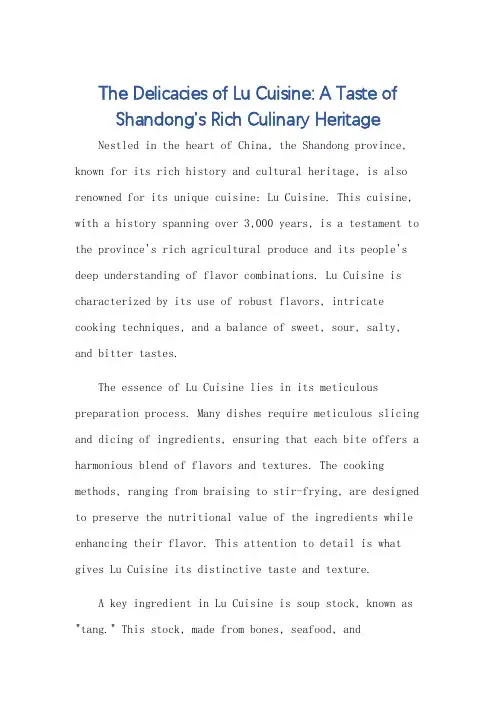
The Delicacies of Lu Cuisine: A Taste ofShandong's Rich Culinary HeritageNestled in the heart of China, the Shandong province, known for its rich history and cultural heritage, is also renowned for its unique cuisine: Lu Cuisine. This cuisine, with a history spanning over 3,000 years, is a testament to the province's rich agricultural produce and its people's deep understanding of flavor combinations. Lu Cuisine is characterized by its use of robust flavors, intricate cooking techniques, and a balance of sweet, sour, salty, and bitter tastes.The essence of Lu Cuisine lies in its meticulous preparation process. Many dishes require meticulous slicing and dicing of ingredients, ensuring that each bite offers a harmonious blend of flavors and textures. The cooking methods, ranging from braising to stir-frying, are designed to preserve the nutritional value of the ingredients while enhancing their flavor. This attention to detail is what gives Lu Cuisine its distinctive taste and texture.A key ingredient in Lu Cuisine is soup stock, known as "tang." This stock, made from bones, seafood, andvegetables, is the foundation of many dishes and isbelieved to enhance the flavor of the final dish. It isoften simmered for hours to extract the maximum flavor and nutrition from the ingredients. The result is a rich, flavorful broth that adds depth and complexity to LuCuisine dishes.Another distinctive feature of Lu Cuisine is its use of seafood. The Shandong province is home to a vast coastline, providing an abundance of fresh seafood. Dishes like "Jiaozi" (dumplings filled with seafood and vegetables) and "Laoshu Seafood Soup" are testaments to the province's rich seafood resources and the skill of its chefs in preparing them.But Lu Cuisine is not just about robust flavors and intricate cooking techniques. It is also about presentation. Dishes are often arranged in beautiful patterns, withcolors and textures that complement each other, making them not only tasty but also visually appealing.The influence of Lu Cuisine extends beyond Shandong.Its unique flavors and cooking techniques have influencedcuisines across China, making it one of the mostinfluential cuisines in Chinese culinary history.In conclusion, Lu Cuisine is not just a cuisine; it is a cultural phenomenon that reflects the rich history, agricultural produce, and culinary skills of the Shandong province. It is a testament to the people's deep understanding of flavor combinations and their commitment to preserving and enhancing their culinary heritage. As you delve into the delicacies of Lu Cuisine, you are not just tasting food; you are tasting a piece of Shandong's rich cultural history.**鲁菜介绍**在中华大地的心脏地带,山东省以其丰富的历史和文化遗产而闻名,同时,其独特的菜系——鲁菜也备受赞誉。
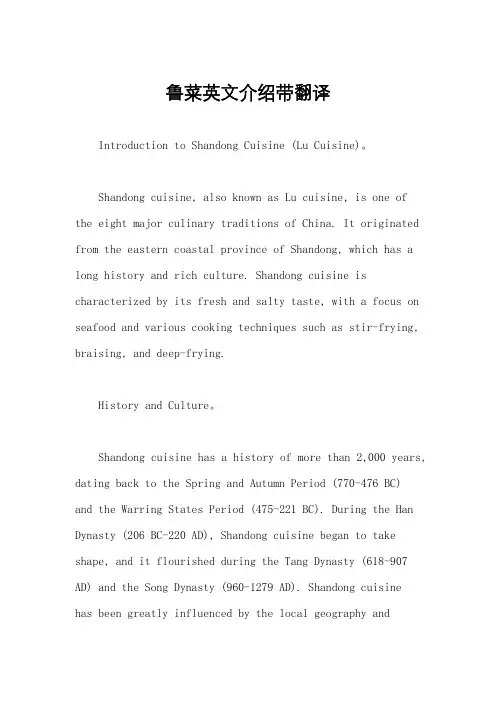
鲁菜英文介绍带翻译Introduction to Shandong Cuisine (Lu Cuisine)。
Shandong cuisine, also known as Lu cuisine, is one of the eight major culinary traditions of China. It originated from the eastern coastal province of Shandong, which has a long history and rich culture. Shandong cuisine is characterized by its fresh and salty taste, with a focus on seafood and various cooking techniques such as stir-frying, braising, and deep-frying.History and Culture。
Shandong cuisine has a history of more than 2,000 years, dating back to the Spring and Autumn Period (770-476 BC)and the Warring States Period (475-221 BC). During the Han Dynasty (206 BC-220 AD), Shandong cuisine began to take shape, and it flourished during the Tang Dynasty (618-907 AD) and the Song Dynasty (960-1279 AD). Shandong cuisinehas been greatly influenced by the local geography andclimate, as well as the cultural exchanges with neighboring regions.Ingredients and Flavors。
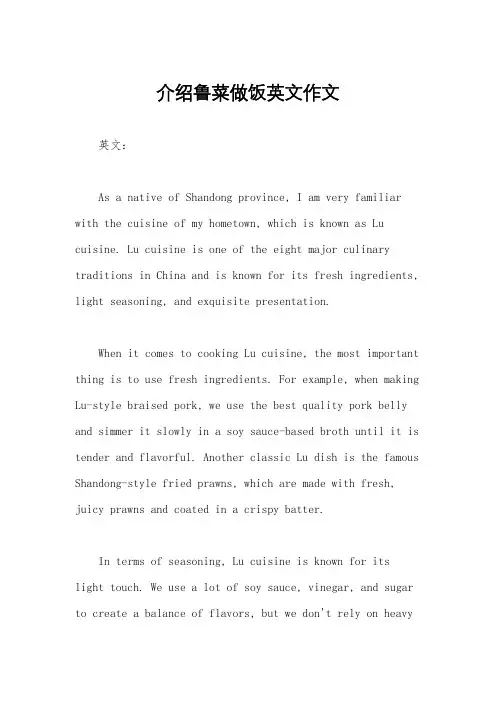
介绍鲁菜做饭英文作文英文:As a native of Shandong province, I am very familiar with the cuisine of my hometown, which is known as Lu cuisine. Lu cuisine is one of the eight major culinary traditions in China and is known for its fresh ingredients, light seasoning, and exquisite presentation.When it comes to cooking Lu cuisine, the most important thing is to use fresh ingredients. For example, when making Lu-style braised pork, we use the best quality pork belly and simmer it slowly in a soy sauce-based broth until it is tender and flavorful. Another classic Lu dish is the famous Shandong-style fried prawns, which are made with fresh, juicy prawns and coated in a crispy batter.In terms of seasoning, Lu cuisine is known for itslight touch. We use a lot of soy sauce, vinegar, and sugar to create a balance of flavors, but we don't rely on heavyspices or seasonings. This allows the natural flavors of the ingredients to shine through.Finally, presentation is also very important in Lu cuisine. We pay a lot of attention to the visual appeal of our dishes, using colorful vegetables and garnishes to create a beautiful and appetizing plate.Overall, cooking Lu cuisine requires a lot of skill and attention to detail, but the end result is always worth it. From the tender braised pork to the crispy fried prawns, Lu cuisine is a delicious and sophisticated culinary tradition that is sure to impress.中文:作为山东人,我非常熟悉我的家乡菜系——鲁菜。
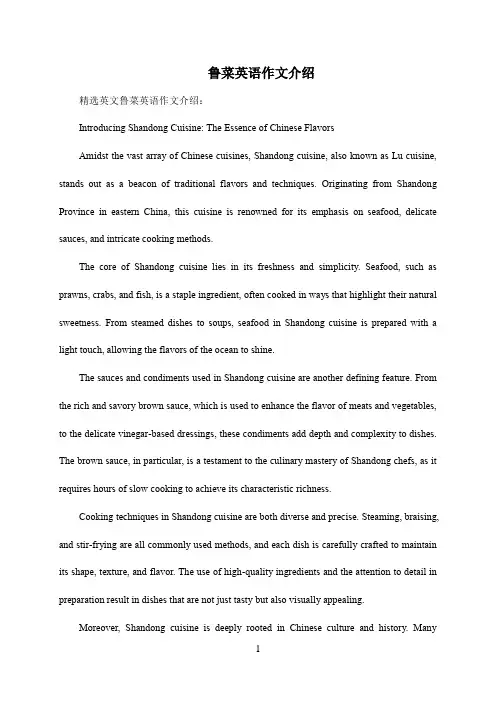
鲁菜英语作文介绍精选英文鲁菜英语作文介绍:Introducing Shandong Cuisine: The Essence of Chinese FlavorsAmidst the vast array of Chinese cuisines, Shandong cuisine, also known as Lu cuisine, stands out as a beacon of traditional flavors and techniques. Originating from Shandong Province in eastern China, this cuisine is renowned for its emphasis on seafood, delicate sauces, and intricate cooking methods.The core of Shandong cuisine lies in its freshness and simplicity. Seafood, such as prawns, crabs, and fish, is a staple ingredient, often cooked in ways that highlight their natural sweetness. From steamed dishes to soups, seafood in Shandong cuisine is prepared with a light touch, allowing the flavors of the ocean to shine.The sauces and condiments used in Shandong cuisine are another defining feature. From the rich and savory brown sauce, which is used to enhance the flavor of meats and vegetables, to the delicate vinegar-based dressings, these condiments add depth and complexity to dishes. The brown sauce, in particular, is a testament to the culinary mastery of Shandong chefs, as it requires hours of slow cooking to achieve its characteristic richness.Cooking techniques in Shandong cuisine are both diverse and precise. Steaming, braising, and stir-frying are all commonly used methods, and each dish is carefully crafted to maintain its shape, texture, and flavor. The use of high-quality ingredients and the attention to detail in preparation result in dishes that are not just tasty but also visually appealing.Moreover, Shandong cuisine is deeply rooted in Chinese culture and history. Manydishes have stories and legends associated with them, reflecting the rich tapestry of Shandong's cultural heritage. Eating Shandong cuisine is not just a culinary experience; it's a journey through the province's history and traditions.In conclusion, Shandong cuisine is a must-try for anyone interested in exploring the vast and diverse world of Chinese food. From the freshness of the seafood to the intricate sauces and cooking techniques, Shandong cuisine offers a unique and unforgettable dining experience.中文对照翻译:鲁菜简介:中国风味的精髓鲁菜,也被称为鲁菜,在中国众多美食中脱颖而出,成为传统风味和工艺的灯塔。
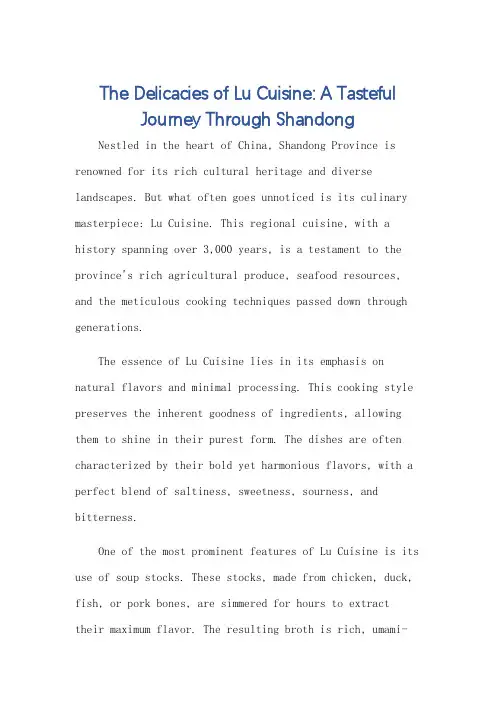
The Delicacies of Lu Cuisine: A TastefulJourney Through ShandongNestled in the heart of China, Shandong Province is renowned for its rich cultural heritage and diverse landscapes. But what often goes unnoticed is its culinary masterpiece: Lu Cuisine. This regional cuisine, with a history spanning over 3,000 years, is a testament to the province's rich agricultural produce, seafood resources, and the meticulous cooking techniques passed down through generations.The essence of Lu Cuisine lies in its emphasis on natural flavors and minimal processing. This cooking style preserves the inherent goodness of ingredients, allowing them to shine in their purest form. The dishes are often characterized by their bold yet harmonious flavors, with a perfect blend of saltiness, sweetness, sourness, and bitterness.One of the most prominent features of Lu Cuisine is its use of soup stocks. These stocks, made from chicken, duck, fish, or pork bones, are simmered for hours to extracttheir maximum flavor. The resulting broth is rich, umami-packed, and forms the backbone of many Lu dishes,particularly those involving seafood and poultry.Seafood plays a pivotal role in Lu Cuisine, with Shandong's coastline providing an abundance of fresh fish, shellfish, and crustaceans. Dishes like Steamed Crab with Yellow Bean Sauce and Braised Fish with Soy Sauce are not only delicious but also reflect the cuisine's respect forthe sea and its bounty.Poultry and meat dishes are also a staple of Lu Cuisine. Dishes like Braised Chicken with Brown Sauce and Red-Cooked Pork Belly are known for their tender meat and rich, savory sauce. These dishes are often served with a side of steamed rice, a perfect complement to their rich flavors.Vegetables are another essential ingredient in Lu dishes. The cuisine boasts a wide range of vegetable-based dishes, many of which are cooked with the same care and attention as their meat counterparts. Stir-fried vegetables, pickled vegetables, and vegetable stews are all common inLu Cuisine, each offering a unique flavor experience.But what truly sets Lu Cuisine apart is its dedicationto culinary perfection. Chefs in Shandong are renowned fortheir meticulous attention to detail, from selecting the freshest ingredients to mastering the perfect cooking technique. This commitment to excellence ensures that every dish is a culinary masterpiece, worthy of being savored and enjoyed.In conclusion, Lu Cuisine is not just a collection of dishes; it's a cultural phenomenon that embodies Shandong's rich history, traditions, and culinary ingenuity. It's a tasteful journey through the province's diverse landscapes and a celebration of its people's love for food and cooking. As you delve into the flavors of Lu Cuisine, you're notjust tasting food; you're experiencing a taste ofShandong's soul.**鲁菜:一场穿越山东的美食之旅**位于中国心脏地带的山东省,以其丰富的文化遗产和多样的景观而闻名。
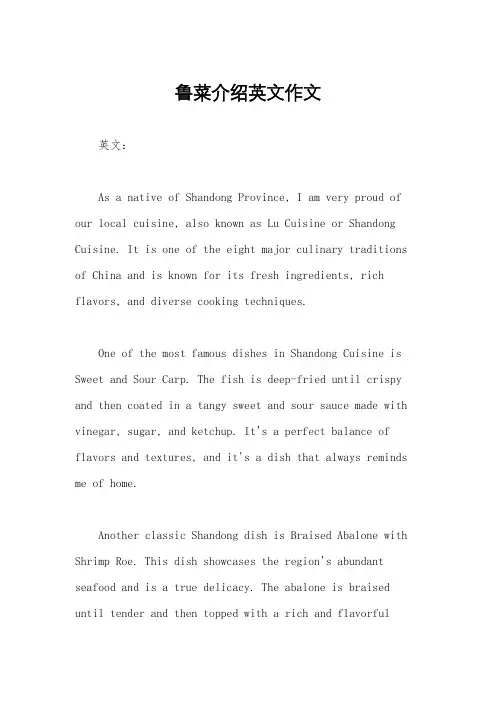
鲁菜介绍英文作文英文:As a native of Shandong Province, I am very proud of our local cuisine, also known as Lu Cuisine or Shandong Cuisine. It is one of the eight major culinary traditions of China and is known for its fresh ingredients, rich flavors, and diverse cooking techniques.One of the most famous dishes in Shandong Cuisine is Sweet and Sour Carp. The fish is deep-fried until crispy and then coated in a tangy sweet and sour sauce made with vinegar, sugar, and ketchup. It's a perfect balance of flavors and textures, and it's a dish that always reminds me of home.Another classic Shandong dish is Braised Abalone with Shrimp Roe. This dish showcases the region's abundant seafood and is a true delicacy. The abalone is braised until tender and then topped with a rich and flavorfulshrimp roe sauce. It's a dish that is often served atspecial occasions and represents the elegance and sophistication of Shandong Cuisine.In addition to these iconic dishes, Shandong Cuisinealso features a wide variety of soups, stir-fries, and steamed dishes. One of my personal favorites is Stir-fried Clams with Garlic. The clams are quickly cooked with garlic, ginger, and scallions, resulting in a dish that is bursting with umami flavors and is incredibly satisfying.Overall, Shandong Cuisine is characterized by its emphasis on fresh and seasonal ingredients, as well as its use of bold and vibrant flavors. It's a cuisine that is deeply rooted in tradition but also embraces innovation and creativity.中文:作为山东人,我为我们的鲁菜感到非常自豪。
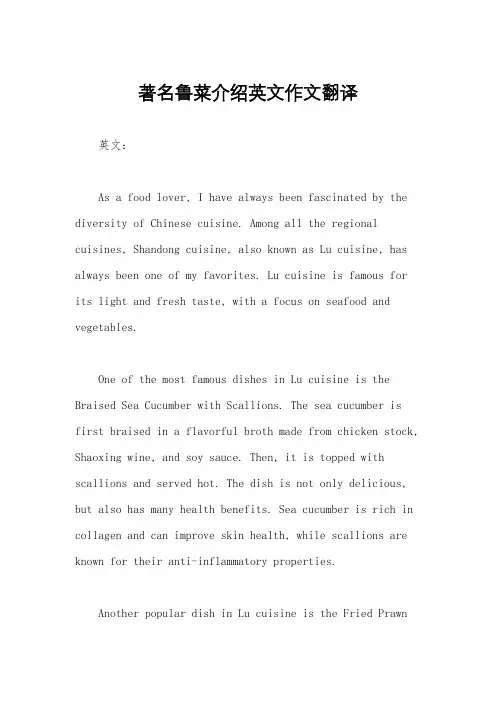
著名鲁菜介绍英文作文翻译英文:As a food lover, I have always been fascinated by the diversity of Chinese cuisine. Among all the regional cuisines, Shandong cuisine, also known as Lu cuisine, has always been one of my favorites. Lu cuisine is famous for its light and fresh taste, with a focus on seafood and vegetables.One of the most famous dishes in Lu cuisine is the Braised Sea Cucumber with Scallions. The sea cucumber is first braised in a flavorful broth made from chicken stock, Shaoxing wine, and soy sauce. Then, it is topped with scallions and served hot. The dish is not only delicious, but also has many health benefits. Sea cucumber is rich in collagen and can improve skin health, while scallions are known for their anti-inflammatory properties.Another popular dish in Lu cuisine is the Fried Prawnwith Salted Egg Yolk. The prawns are first marinated in a mixture of salt, pepper, and cornstarch, then deep-fried until crispy. The salted egg yolk is then added to the dish, giving it a rich and savory flavor. This dish is perfect as a side dish or as a main course with steamed rice.中文:作为一名美食爱好者,我一直被中国菜的多样性所吸引。
鲁菜特点英文简短介绍作文英文:As a native of Shandong province, I am very familiar with the cuisine of my region, including the famous Lu cuisine. Lu cuisine is known for its light and delicate flavors, with an emphasis on fresh ingredients and natural seasonings.One of the most distinctive features of Lu cuisine is its use of seafood, particularly in dishes like braised abalone and shrimp with green beans. Another hallmark of Lu cuisine is its emphasis on soups and broths, which are often made with chicken or pork bones and simmered for hours to extract maximum flavor.Lu cuisine also features a wide variety of vegetable dishes, including stir-fried cabbage and sautéed spinach with garlic. These dishes are often lightly seasoned with soy sauce, vinegar, and other simple ingredients topreserve the natural flavor of the vegetables.In addition to its emphasis on fresh ingredients and natural seasonings, Lu cuisine is also known for its attention to presentation. Many dishes are arranged in intricate patterns or served in beautiful ceramic or porcelain dishes, making them both delicious and visually appealing.Overall, Lu cuisine is a testament to the rich culinary traditions of Shandong province, and its delicate flavors and beautiful presentation make it a true delight for food lovers everywhere.中文:作为山东人,我非常熟悉本地的美食,其中包括著名的鲁菜。
鲁菜介绍英语作文Introduction to Shandong Cuisine (鲁菜介绍)Shandong Cuisine, also known as Lu Cuisine (鲁菜), is one of the eight major culinary traditions of China. It originated in Shandong Province, which is located on the eastern coast of China. Shandong Cuisine is characterized by its emphasis on freshness, crispness, aroma, and taste. It is considered one of the most influential and prestigious regional cuisines in China.Shandong Cuisine can be divided into two main styles: Jinan cuisine and Jiaodong cuisine. Jinan cuisine is known for its use of soup and seafood, while Jiaodong cuisine focuses on seafood dishes. Both styles share common characteristics such as the use of vinegar, garlic, and scallions to enhance the flavor of the dishes.Key ingredients in Shandong Cuisine include seafood, poultry, pork, and various vegetables. Seafood is particularly important in Shandong Cuisine due to the province's proximity to the Yellow Sea. Some popular seafood dishes include sweet and sour carp, braised abalone, and shrimp with garlic sauce.One of the most iconic dishes in Shandong Cuisine is Peking duck, which originated in Beijing but has roots in Shandongcuisine. The dish features crispy duck skin and tender meat served with thin pancakes, scallions, and hoisin sauce.Another famous dish is Braised Chicken with Scallion, which consists of succulent chicken pieces cooked in a savory sauce with fresh scallions. The dish is flavorful and aromatic, making it a favorite among locals and visitors alike.Other popular dishes in Shandong Cuisine include Braised Pork Belly, Stir-fried Clams, and Shandong Pancake. These dishes showcase the diversity and richness of Shandong Cuisine, which has a long history dating back to ancient times.In addition to its delicious dishes, Shandong Cuisine is also known for its culinary techniques such as braising, stewing, and stir-frying. These techniques help create dishes that are flavorful, tender, and visually appealing.Overall, Shandong Cuisine is a culinary treasure that reflects the unique flavors and traditions of Shandong Province. Its emphasis on freshness, aroma, and taste make it a favorite among food enthusiasts worldwide. Whether you are a seafood lover or a fan of savory dishes, Shandong Cuisine has something for everyone to enjoy.。
著名鲁菜介绍英文作文英文:As a food lover, I'm always on the lookout for new and exciting dishes to try. One cuisine that has always intrigued me is Shandong cuisine, or Lu cuisine as it's commonly known. Lu cuisine is known for its emphasis on seafood, especially shellfish, and its use of vinegar and garlic to create bold and savory flavors.One of the most famous dishes in Lu cuisine is sweet and sour carp. This dish features a whole carp that is deep-fried until crispy and then coated in a sweet and sour sauce made with vinegar, sugar, and tomato paste. Theresult is a dish that is both crispy and tangy, with a perfect balance of sweet and sour flavors.Another popular dish in Lu cuisine is braised abalone. Abalone is a type of shellfish that is prized for its tender texture and delicate flavor. In this dish, abaloneis simmered in a rich broth made with soy sauce, ginger,and scallions. The result is a dish that is both savory and satisfying, with a melt-in-your-mouth texture that is hardto resist.Overall, I think Lu cuisine is a must-try for any food lover. Its bold flavors and emphasis on seafood make it a unique and exciting cuisine to explore. Whether you're afan of sweet and sour dishes or prefer something more savory, there is something for everyone in Lu cuisine.中文:作为一名美食爱好者,我总是在寻找新的、令人兴奋的菜肴尝试。
著名鲁菜介绍英文作文英文:When it comes to famous cuisines in China, Shandong cuisine, also known as Lu cuisine, is definitely one of them. As a native of Shandong province, I am proud to introduce this delicious and unique cuisine to the world.Lu cuisine is characterized by its emphasis on aroma, freshness, and crispiness. It uses a variety of cooking techniques, such as stir-frying, braising, and deep-frying, to create dishes that are both flavorful and visually appealing. Some of the most famous dishes include braised sea cucumber with scallions, stir-fried pork with sweet bean sauce, and deep-fried yellow croaker.One of the signature ingredients in Lu cuisine is vinegar. Shandong vinegar, also known as black vinegar, is made from wheat, barley, and peas, and has a mellow and slightly sweet taste. It is often used to balance out therichness of meat and seafood dishes, and also adds a unique flavor to soups and stews.Another unique aspect of Lu cuisine is its use of condiments and sauces. For example, sweet bean sauce, made from fermented soybeans and sugar, is often used to add sweetness and umami to stir-fried dishes. Spicy garlic sauce, made from garlic, chili peppers, and vinegar, is a popular dipping sauce for dumplings and other snacks.In addition to its delicious taste, Lu cuisine also has a rich cultural heritage. Many of the dishes have been passed down for generations, and are closely tied to the history and traditions of Shandong province. For example, the famous dish "eight treasures duck" is said to have been created by a chef in the Qing dynasty, who used eight different ingredients to stuff a whole duck and then braised it to perfection.中文:说到中国著名的菜系,山东菜,也称鲁菜,绝对是其中之一。
鲁菜:中国美食的璀璨瑰宝Shandong cuisine, also known as Lu cuisine, is a renowned culinary tradition in China, renowned for its rich flavors, diverse cooking techniques, and historical depth. Originating from the Shandong province, this cuisine has a long-standing reputation for its deliciousness and nutritional value, making it a favorite among food lovers worldwide.The essence of Shandong cuisine lies in its emphasis on freshness and natural flavors. Seafood, especially, is a cornerstone of this cuisine, as Shandong is a coastal province blessed with an abundance of marine resources. Dishes like steamed fish and seafood stir-fry are prepared with minimal seasoning, allowing the inherent sweetness and freshness of the ingredients to shine through.Moreover, Shandong cuisine is renowned for itsintricate cooking techniques, such as braising, stewing, and frying. These techniques, combined with traditional seasonings like soy sauce, vinegar, and ginger, create dishes that are both flavorful and visually appealing. Classic examples include braised pork belly and sweet andsour ribs, which showcase the cuisine's balance of savory and sweet flavors.In addition to seafood and meat dishes, Shandong cuisine also offers a variety of vegetarian options. Dishes like stir-fried vegetables and tofu dishes are prepared with care and attention to detail, highlighting the freshness and nutritional value of vegetables.What sets Shandong cuisine apart is its historical and cultural significance. Many dishes have deep roots in the province's rich history and traditions. For instance, the famous "Eight Treasures of Shandong" refers to eightclassic dishes that have been passed down through generations, each representing a unique flavor and cooking technique.Furthermore, Shandong cuisine is not just about taste; it's also about presentation. Dishes are often arranged in visually appealing ways, with intricate cuts and decorative elements that add to their overall appeal. This attention to detail is a testament to the cuisine's sophistication and elegance.In conclusion, Shandong cuisine is a vibrant and diverse culinary tradition that offers a delicious blend of flavors and textures. From its emphasis on freshness and natural flavors to its intricate cooking techniques and historical significance, this cuisine is a must-try for any food lover. Whether you're a seafood enthusiast, a meat lover, or a vegetarian, Shandong cuisine has something to satisfy your taste buds.**鲁菜:中国美食的璀璨瑰宝**鲁菜,又称山东菜,是中国著名的烹饪传统之一,以其风味浓郁、烹饪技法多样和历史底蕴深厚而享誉中外。
鲁菜的详细介绍英文作文英文回答:Shandong cuisine, also known as Lu cuisine, is one of the Eight Great Cuisines of China and is renowned for its distinctive flavors, textures, and cooking techniques. Originating in the Shandong province of Eastern China, Lu cuisine has a rich history dating back centuries and has been influenced by various cultural and geographical factors.One of the defining characteristics of Shandong cuisine is its emphasis on fresh, seasonal ingredients. Chefs prioritize using locally sourced produce, seafood, and meats to ensure the highest quality and freshness in their dishes. This focus on ingredients is evident in the vibrant colors, crisp textures, and delicate flavors that are characteristic of Lu cuisine.Another notable aspect of Lu cuisine is its emphasis onprecise cooking techniques. Chefs employ a variety of methods, including stir-frying, braising, steaming, and roasting, to create dishes that showcase the naturalflavors of the ingredients while maintaining their textures and nutritional value. Lu cuisine is also known for its use of sauces, which often incorporate soy sauce, vinegar, and garlic to enhance the flavors of the dishes.In terms of flavors, Lu cuisine is generally characterized by its balance and subtlety. While dishes may incorporate bold ingredients like garlic and ginger, the flavors are typically harmonious and well-integrated. Chefs strive to create a balance between salty, sweet, sour, and bitter elements to achieve a complex and satisfying taste experience.Overall, Shandong cuisine is a vibrant and diverse culinary tradition that has earned its place as one of the most esteemed cuisines in China. Its focus on fresh ingredients, precise cooking techniques, and balanced flavors has made it a favorite among food enthusiasts worldwide.中文回答:鲁菜,又称鲁菜,是中国八大菜系之一,以其独特风味、口感和烹饪技巧而闻名。